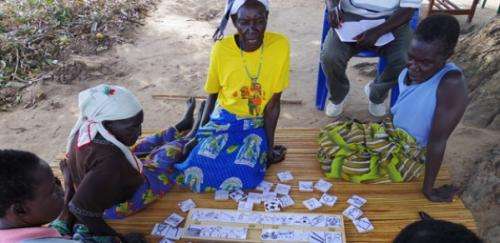Keeping the lights on in rural Uganda

Stephanie Hirmer, a PhD student from the Department of Engineering's Centre for Sustainable Development, is investigating the value-perception of the users of rural electrification projects in Uganda.
As part of her investigations, Stephanie travelled to Moyo in northern Uganda to ask which possessions the villagers most value and why. The results will be used to help reduce the failure rate of projects that bring electricity to rural communities there. In this article she talks about her experiences there:
"If I have a flush toilet in my house I think I can be a king of all kings because I can't go out on those squatting latrines… also it can protect my wife from going outside alone as recently my wife was almost raped by a thug when she escorted my son to the latrine at around 10:30pm in the night."
This is Paul. His declaration of the possession he would most value is met with laughter from his fellow villagers, but it highlights a very real concern – the safety of his family.
It's also a valuable research finding for me. Too often, projects that bring electricity to villages like Paul's fail because of lack of uptake and maintenance by the rural communities. But if, for instance, the benefits of electrification could be understood in terms of the safety value of night-time lighting, this could improve the sense of community responsibility towards sustaining the technology after its implementers have gone home.
Another villager, Michael, explains that he places most value in owning a corrugated iron sheet instead of grassthatched roofing because this would reduce the risk of indoor fires. Here too, the value of electricity can be highlighted – it would avoid the need to cook on an open fire.
Understanding the locals' real needs and desires can be a key element in overcoming the lack of technology uptake. Finding out what these are is the aim of my PhD research, working with Dr Heather Cruickshank at the Centre for Sustainable Development. While the technology itself has been extensively studied, social attributes in project design have received little attention.
I have travelled here by a 'boda boda' motorbike and then night bus, sharing my seat on the 12-hour journey on unpaved roads to the West Nile Region of Uganda with two too many people, a goat lying beneath me, and enough chickens not to be able to ignore the smell. Only once I am on the bus do I realise that my local research assistant has accidentally booked us on the budget bus (only US$2 cheaper than the luxury coach).
To provide better infrastructure services to rural communities, it is fundamentally important to relate to the beneficiaries' needs and aspirations, and I need to travel to the areas to learn this at first hand. Infrastructure failure after the projects are handed over to the communities is common across the basic utility provisions such as water and electrification, and I am keen to discover if there is a way of improving project longevity by 'selling' a service that is valued.
Seven villages, with three days of focus group discussions per village, seem like an achievable task in the two months scheduled. Today is the first day of fieldwork and we have arrived at the village of Moyo for the day's focus group discussions. The village is still very familiar to me; not much has changed since my last visit three years ago when I was working with the German Development Agency, GIZ, on the installation of the community-operated pico-hydropower scheme. These schemes are perfect for small communities with about 50 homes that require only enough electricity to power a few light bulbs and a small number of electrical items. In Moyo, however, the scheme no longer works, and the villagers are once more plunged into darkness while a more effective solution is being explored.
We meet one of the women to mobilise the six chosen villagers. We decide to start with the men, as by late morning some of the men in the village will be drunk.
Identifying what is important to rural villagers when implementing basic infrastructure projects is far more complex than simply asking "what is important to you?" I have made a 'value game' and explain to the locals that they must choose, initially individually, 20 items from a list of approximately 50 items that include cow, hoe, fridge, water pot, bed and utensils. Following prioritisation, they will be asked to give reasons as to why these items are important to them.
Another example arises during the discussion. The villagers use kerosene lamps to light their homes. Simply offering a solution that replaces light from one source with another is not enough. Modern technologies can offer benefits that are indirectly linked to aspects perceived as 'very important' in rural communities – in this case, avoiding the use of fume-producing kerosene would resonate with the mothers' hopes of keeping their children healthy.
The findings from my research will be fed back to project implementers. My hope is that only small adjustments in the project design will be required in order to communicate these 'additional' benefits to the target users, and that the lights will be turned on and kept on in rural villages like Moyo.
Provided by University of Cambridge

















